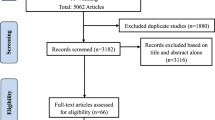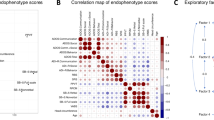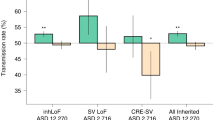Key Points
-
Over the past 5 years, researchers have identified many genetic factors that increase the risk of autism spectrum disorder (ASD), and that might shed light on more-homogeneous subgroups within the spectrum
-
The most robustly identified genetic risks for ASD are rare mutations with large effect; studies have been underpowered to detect common genetic variation
-
The role of rare genetic variants supports the relevance of studying monogenic disorders, such as tuberous sclerosis complex, for understanding ASD pathophysiology
-
The most parsimonious explanation for the male predominance in ASD involves the presence of protective factors that reduce the risk of ASD in females
-
Many genetic mutations associated with ASD also confer high risk of comorbidities including epilepsy, motor impairment and sleep disturbance
-
Genetic testing including chromosomal microarray analysis is warranted and clinically indicated for all suspected cases of ASD
Abstract
Autism spectrum disorder (ASD) represents a heterogeneous group of disorders, which presents a substantial challenge to diagnosis and treatment. Over the past decade, considerable progress has been made in the identification of genetic risk factors for ASD that define specific mechanisms and pathways underlying the associated behavioural deficits. In this Review, we discuss how some of the latest advances in the genetics of ASD have facilitated parsing of the phenotypic heterogeneity of this disorder. We argue that only through such advances will we begin to define endophenotypes that can benefit from targeted, hypothesis-driven treatments. We review the latest technologies used to identify and characterize the genetics underlying ASD and then consider three themes—single-gene disorders, the gender bias in ASD, and the genetics of neurological comorbidities—that highlight ways in which we can use genetics to define the many phenotypes within the autism spectrum. We also present current clinical guidelines for genetic testing in ASD and their implications for prognosis and treatment.
This is a preview of subscription content, access via your institution
Access options
Subscribe to this journal
Receive 12 print issues and online access
$209.00 per year
only $17.42 per issue
Buy this article
- Purchase on Springer Link
- Instant access to full article PDF
Prices may be subject to local taxes which are calculated during checkout



Similar content being viewed by others
References
American Psychiatric Association. Diagnostic and Statistical Manual of Mental Disorders, 5th Edition (DSM-5) (American Psychiatric Association, 2013).
Geschwind, D. H. & Levitt, P. Autism spectrum disorders: developmental disconnection syndromes. Curr. Opin. Neurobiol. 17, 103–111 (2007).
Hus, V., Pickles, A., Cook, E. H. Jr, Risi, S. & Lord, C. Using the autism diagnostic interview—revised to increase phenotypic homogeneity in genetic studies of autism. Biol. Psychiatry 61, 438–448 (2007).
Anderson, D. K. et al. Patterns of growth in verbal abilities among children with autism spectrum disorder. J. Consult. Clin. Psychol. 75, 594–604 (2007).
Burrell, R. A., McGranahan, N., Bartek, J. & Swanton, C. The causes and consequences of genetic heterogeneity in cancer evolution. Nature 501, 338–345 (2013).
Belgard, T. G., Jankovic, I., Lowe, J. K. & Geschwind, D. H. Population structure confounds autism genetic classifier. Mol. Psychiatry http://dx.doi.org/10.1038/mp.2013.34.
Smalley, S. L., Asarnow, R. F. & Spence, M. A. Autism and genetics. A decade of research. Arch. Gen. Psychiatry 45, 953–961 (1988).
Neale, B. M. et al. Patterns and rates of exonic de novo mutations in autism spectrum disorders. Nature 485, 242–245 (2012).
O'Roak, B. J. et al. Sporadic autism exomes reveal a highly interconnected protein network of de novo mutations. Nature 485, 246–250 (2012).
Malhotra, D. & Sebat, J. CNVs: harbingers of a rare variant revolution in psychiatric genetics. Cell 148, 1223–1241 (2012).
Heil, K. M. & Schaaf, C. P. The genetics of autism spectrum disorders—a guide for clinicians. Curr. Psychiatry Rep. 15, 334 (2013).
Stein, J. L., Parikshak, N. N. & Geschwind, D. H. Rare inherited variation in autism: beginning to see the forest and a few trees. Neuron 77, 209–211 (2013).
Sanders, S. J. et al. De novo mutations revealed by whole-exome sequencing are strongly associated with autism. Nature 485, 237–241 (2012).
Yu, T. W. et al. Using whole-exome sequencing to identify inherited causes of autism. Neuron 77, 259–273 (2013).
Berg, J. M. & Geschwind, D. H. Autism genetics: searching for specificity and convergence. Genome Biol. 13, 247 (2012).
Huang, J. & Manning, B. D. The TSC1–TSC2 complex: a molecular switchboard controlling cell growth. Biochem. J. 412, 179–190 (2008).
Choi, Y. J. et al. Tuberous sclerosis complex proteins control axon formation. Genes Dev. 22, 2485–2495 (2008).
Curatolo, P., Bombardieri, R. & Jozwiak, S. Tuberous sclerosis. Lancet 372, 657–668 (2008).
Jeste, S. S., Sahin, M., Bolton, P., Ploubidis, G. B. & Humphrey, A. Characterization of autism in young children with tuberous sclerosis complex. J. Child Neurol. 23, 520–525 (2008).
Bolton, P. F., Park, R. J., Higgins, J. N., Griffiths, P. D. & Pickles, A. Neuro-epileptic determinants of autism spectrum disorders in tuberous sclerosis complex. Brain 125, 1247–1255 (2002).
Jambaque, I. et al. Neuropsychological aspects of tuberous sclerosis in relation to epilepsy and MRI findings. Dev. Med. Child Neurol. 33, 698–705 (1991).
Eluvathingal, T. J. et al. Cerebellar lesions in tuberous sclerosis complex: neurobehavioral and neuroimaging correlates. J. Child Neurol. 21, 846–851 (2006).
Weber, A. M., Egelhoff, J. C., McKellop, J. M. & Franz, D. N. Autism and the cerebellum: evidence from tuberous sclerosis. J. Autism Dev. Disord. 30, 511–517 (2000).
Nie, D. et al. Tsc2–Rheb signaling regulates EphA-mediated axon guidance. Nat. Neurosci. 13, 163–172 (2010).
Meikle, L. et al. A mouse model of tuberous sclerosis: neuronal loss of Tsc1 causes dysplastic and ectopic neurons, reduced myelination, seizure activity, and limited survival. J. Neurosci. 27, 5546–5558 (2007).
Widjaja, E. et al. Diffusion tensor imaging identifies changes in normal-appearing white matter within the epileptogenic zone in tuberous sclerosis complex. Epilepsy Res. 89, 246–253 (2010).
Garaci, F. G. et al. Increased brain apparent diffusion coefficient in tuberous sclerosis. Radiology 232, 461–465 (2004).
Krishnan, M. L. et al. Diffusion features of white matter in tuberous sclerosis with tractography. Pediatr. Neurol. 42, 101–106 (2010).
Peng, S. S., Lee, W. T., Wang, Y. H. & Huang, K. M. Cerebral diffusion tensor images in children with tuberous sclerosis: a preliminary report. Pediatr. Radiol. 34, 387–392 (2004).
Ehninger, D. et al. Reversal of learning deficits in a Tsc2+/− mouse model of tuberous sclerosis. Nat. Med. 14, 843–848 (2008).
Goorden, S. M., van Woerden, G. M., van der Weerd, L., Cheadle, J. P. & Elgersma, Y. Cognitive deficits in Tsc1+/− mice in the absence of cerebral lesions and seizures. Ann. Neurol. 62, 648–655 (2007).
Tsai, P. T. et al. Autistic-like behaviour and cerebellar dysfunction in Purkinje cell Tsc1 mutant mice. Nature 488, 647–651 (2012).
Bissler, J. J. et al. Everolimus for angiomyolipoma associated with tuberous sclerosis complex or sporadic lymphangioleiomyomatosis (EXIST-2): a multicentre, randomised, double-blind, placebo-controlled trial. Lancet 381, 817–824 (2013).
Bissler, J. J. et al. Sirolimus for angiomyolipoma in tuberous sclerosis complex or lymphangioleiomyomatosis. N. Engl. J. Med. 358, 140–151 (2008).
US National Library of Medicine. ClinicalTrials.gov [online], (2013).
Sahin, M. Targeted treatment trials for tuberous sclerosis and autism: no longer a dream. Curr. Opin. Neurobiol. 22, 895–901 (2012).
Berry-Kravis, E. et al. A pilot open label, single dose trial of fenobam in adults with fragile X syndrome. J. Med. Genet. 46, 266–271 (2009).
Berry-Kravis, E. et al. Open-label treatment trial of lithium to target the underlying defect in fragile X syndrome. J. Dev. Behav. Pediatr. 29, 293–302 (2008).
Berry-Kravis, E. M. et al. Effects of STX209 (arbaclofen) on neurobehavioral function in children and adults with fragile X syndrome: a randomized, controlled, phase 2 trial. Sci. Transl. Med. 4, 152ra127 (2012).
Paribello, C. et al. Open-label add-on treatment trial of minocycline in fragile X syndrome. BMC Neurol. 10, 91 (2010).
Pop, A. S., Gomez-Mancilla, B., Neri, G., Willemsen, R. & Gasparini, F. Fragile X syndrome: a preclinical review on metabotropic glutamate receptor 5 (mGluR5) antagonists and drug development. Psychopharmacology (Berl.) http://dx.doi.org/1007/s00213-013-3330–3.
Alarcon, M. et al. Linkage, association, and gene-expression analyses identify CNTNAP2 as an autism-susceptibility gene. Am. J. Hum. Genet. 82, 150–159 (2008).
Arking, D. E. et al. A common genetic variant in the neurexin superfamily member CNTNAP2 increases familial risk of autism. Am. J. Hum. Genet. 82, 160–164 (2008).
Scott-Van Zeeland, A. A. et al. Altered functional connectivity in frontal lobe circuits is associated with variation in the autism risk gene CNTNAP2. Sci. Transl. Med. 2, 56ra80 (2010).
Abrahams, B. S. et al. Genome-wide analyses of human perisylvian cerebral cortical patterning. Proc. Natl Acad. Sci. USA 104, 17849–17854 (2007).
Penagarikano, O. & Geschwind, D. H. What does CNTNAP2 reveal about autism spectrum disorder? Trends Mol. Med. 18, 156–163 (2012).
Fombonne, E. Epidemiology of pervasive developmental disorders. Pediatr. Res. 65, 591–598 (2009).
Prevalence of autism spectrum disorders—Autism and Developmental Disabilities Monitoring Network, 14 sites, United States, 2008. MMWR Surveill. Summ. 61, 1–19 (2012).
Lai, M. C. et al. A behavioral comparison of male and female adults with high functioning autism spectrum conditions. PLoS ONE 6, e20835 (2011).
Zwaigenbaum, L. et al. Sex differences in children with autism spectrum disorder identified within a high-risk infant cohort. J. Autism Dev. Disord. 42, 2585–2596 (2012).
Szatmari, P. et al. Sex differences in repetitive stereotyped behaviors in autism: implications for genetic liability. Am. J. Med. Genet. B Neuropsychiatr. Genet. 159B, 5–12 (2012).
Hattier, M. A., Matson, J. L., Tureck, K. & Horovitz, M. The effects of gender and age on repetitive and/or restricted behaviors and interests in adults with autism spectrum disorders and intellectual disability. Res. Dev. Disabil. 32, 2346–2351 (2011).
Bolte, S., Duketis, E., Poustka, F. & Holtmann, M. Sex differences in cognitive domains and their clinical correlates in higher-functioning autism spectrum disorders. Autism 15, 497–511 (2011).
Solomon, M., Miller, M., Taylor, S. L., Hinshaw, S. P. & Carter, C. S. Autism symptoms and internalizing psychopathology in girls and boys with autism spectrum disorders. J. Autism Dev. Disord. 42, 48–59 (2012).
Dworzynski, K., Ronald, A., Bolton, P. & Happe, F. How different are girls and boys above and below the diagnostic threshold for autism spectrum disorders? J. Am. Acad. Child Adolesc. Psychiatry 51, 788–797 (2012).
Giarelli, E. et al. Sex differences in the evaluation and diagnosis of autism spectrum disorders among children. Disabil. Health J. 3, 107–116 (2010).
Constantino, J. N. & Charman, T. Gender bias, female resilience, and the sex ratio in autism. J. Am. Acad. Child Adolesc. Psychiatry 51, 756–758 (2012).
Werling, D. M. & Geschwind, D. H. Understanding sex bias in autism spectrum disorder. Proc. Natl Acad. Sci. USA 110, 4868–4869 (2013).
Wiznitzer, M. Autism and tuberous sclerosis. J. Child Neurol. 19, 675–679 (2004).
Harrison, J. E. & Bolton, P. F. Annotation: tuberous sclerosis. J. Child Psychol. Psychiatry 38, 603–614 (1997).
Robinson, E. B., Lichtenstein, P., Anckarsater, H., Happe, F. & Ronald, A. Examining and interpreting the female protective effect against autistic behavior. Proc. Natl Acad. Sci. USA 110, 5258–5262 (2013).
Sato, D. et al. SHANK1 deletions in males with autism spectrum disorder. Am. J. Hum. Genet. 90, 879–887 (2012).
Donnelly, S. L. et al. Female with autistic disorder and monosomy X (Turner syndrome): parent-of-origin effect of the X chromosome. Am. J. Med. Genet. 96, 312–316 (2000).
van Rijn, S., Bierman, M., Bruining, H. & Swaab, H. Vulnerability for autism traits in boys and men with an extra X chromosome (47,XXY): the mediating role of cognitive flexibility. J. Psychiatr. Res. 46, 1300–1306 (2012).
Geier, D. A., Kern, J. K., King, P. G., Sykes, L. K. & Geier, M. R. An evaluation of the role and treatment of elevated male hormones in autism spectrum disorders. Acta Neurobiol. Exp. (Wars.) 72, 1–17 (2012).
Jeste, S. S. The neurology of autism spectrum disorders. Curr. Opin. Neurol. 24, 132–139 (2011).
Green, D. et al. Impairment in movement skills of children with autistic spectrum disorders. Dev. Med. Child Neurol. 51, 311–316 (2009).
Fournier, K. A., Hass, C. J., Naik, S. K., Lodha, N. & Cauraugh, J. H. Motor coordination in autism spectrum disorders: a synthesis and meta-analysis. J. Autism. Dev. Disord. 40, 1227–1240 (2010).
Dziuk, M. A. et al. Dyspraxia in autism: association with motor, social, and communicative deficits. Dev. Med. Child Neurol. 49, 734–739 (2007).
Hilton, C. L., Zhang, Y., Whilte, M. R., Klohr, C. L. & Constantino, J. Motor impairment in sibling pairs concordant and discordant for autism spectrum disorders. Autism 16, 430–441 (2012).
Krakowiak, P., Goodlin-Jones, B., Hertz-Picciotto, I., Croen, L. A. & Hansen, R. L. Sleep problems in children with autism spectrum disorders, developmental delays, and typical development: a population-based study. J. Sleep Res. 17, 197–206 (2008).
Wiggs, L. & Stores, G. Severe sleep disturbance and daytime challenging behaviour in children with severe learning disabilities. J. Intellect. Disabil. Res. 40, 518–528 (1996).
Malow, B. A. et al. A practice pathway for the identification, evaluation, and management of insomnia in children and adolescents with autism spectrum disorders. Pediatrics 130 (Suppl. 2), S106–S124 (2012).
Spence, S. J. & Schneider, M. T. The role of epilepsy and epileptiform EEGs in autism spectrum disorders. Pediatr. Res. 65, 599–606 (2009).
Brooks-Kayal, A. Epilepsy and autism spectrum disorders: are there common developmental mechanisms? Brain Dev. 32, 731–738 (2010).
Ben-Yizhak, N. et al. Pragmatic language and school related linguistic abilities in siblings of children with autism. J. Autism Dev. Disord. 41, 750–760 (2011).
Swann, J. W. The effects of seizures on the connectivity and circuitry of the developing brain. Ment. Retard. Dev. Disabil. Res. Rev. 10, 96–100 (2004).
Jozwiak, S. et al. Antiepileptic treatment before the onset of seizures reduces epilepsy severity and risk of mental retardation in infants with tuberous sclerosis complex. Eur. J. Paediatr. Neurol. 15, 424–431 (2011).
Viscidi, E. W. et al. Clinical characteristics of children with autism spectrum disorder and co-occurring epilepsy. PLoS ONE 8, e67797 (2013).
Urraca, N. et al. The interstitial duplication 15q11.2–q13 syndrome includes autism, mild facial anomalies and a characteristic EEG signature. Autism Res. 6, 268–279 (2013).
Filipek, P. A. et al. Practice parameter: screening and diagnosis of autism: report of the Quality Standards Subcommittee of the American Academy of Neurology and the Child Neurology Society. Neurology 55, 468–479 (2000).
Schaefer, G. B. & Mendelsohn, N. J. Genetics evaluation for the etiologic diagnosis of autism spectrum disorders. Genet. Med. 10, 4–12 (2008).
Schaefer, G. B. & Mendelsohn, N. J. Clinical genetics evaluation in identifying the etiology of autism spectrum disorders: 2013 guideline revisions. Genet. Med. 15, 399–407 (2013).
Ozonoff, S. et al. Recurrence risk for autism spectrum disorders: a Baby Siblings Research Consortium study. Pediatrics 128, e488–e495 (2011).
Bolton, P. F. & Griffiths, P. D. Association of tuberous sclerosis of temporal lobes with autism and atypical autism. Lancet 349, 392–395 (1997).
Author information
Authors and Affiliations
Contributions
S. S. Jeste researched data for the article. Both authors made substantial contributions to discussion of the content, writing of the article, and to review and/or editing of the manuscript before submission.
Corresponding author
Ethics declarations
Competing interests
The authors declare no competing financial interests.
Rights and permissions
About this article
Cite this article
Jeste, S., Geschwind, D. Disentangling the heterogeneity of autism spectrum disorder through genetic findings. Nat Rev Neurol 10, 74–81 (2014). https://doi.org/10.1038/nrneurol.2013.278
Published:
Issue Date:
DOI: https://doi.org/10.1038/nrneurol.2013.278
This article is cited by
-
Support vector machine prediction of individual Autism Diagnostic Observation Schedule (ADOS) scores based on neural responses during live eye-to-eye contact
Scientific Reports (2024)
-
Transdiagnostic Patterns of Sensory Processing in Autism and ADHD
Journal of Autism and Developmental Disorders (2024)
-
The subcortical correlates of autistic traits in school-age children: a population-based neuroimaging study
Molecular Autism (2023)
-
Age-related changes in neural responses to sensory stimulation in autism: a cross-sectional study
Molecular Autism (2023)
-
Single-nucleus gene and gene set expression-based similarity network fusion identifies autism molecular subtypes
BMC Bioinformatics (2023)



